Constant Contact Salesforce Integration: The Only Guide You’ll Need
Table of Contents
Imagine if every email you sent from Constant Contact automatically updated your Salesforce leads. That’s exactly what the Constant Contact Salesforce integration does, connecting both platforms to share data and work together automatically.
With this integration, every lead and contact in Salesforce is automatically synced to the right Constant Contact lists for targeted email campaigns. Every open, click, and bounce is captured as a sales activity in real time, giving your team real-time buying intent. But without a proper strategy, it can also lead to duplicate records, irrelevant alerts, and confusing reports.
In this guide, you’ll learn how the Constant Contact Salesforce integration works, its key benefits, and the step-by-step setup process. You’ll also get best practices for the native integration to help you avoid common data and sync issues.
What is Constant Contact?
Constant Contact is a digital marketing platform designed to help businesses by simplifying marketing campaigns with user-friendly tools, automation, and analytics.
In simple terms, Constant Contact is your tool for managing email marketing and helps you build your email list, design a newsletter, and send it to the right people. It tells you who opens the email and clicks on your links.
Key capabilities of Constant Contact
- List management & segmentation: It helps you organize your subscribers into different lists or groups. Also, you can create targeted contact lists based on activity (clicks, opens), signup source, or custom fields.
- Email campaigns: You can create professional emails with a simple drag-and-drop editor, no coding required.
- Engagement tracking: You get to see the performance of email campaigns. It shows you the open rates and click-through rates, so you know what content resonates.
- Automation: You can set up automatic email sequences, like a welcome series for new subscribers.
- Marketing automation: You can set up automated email campaigns/series (e.g., welcome series for new customers) and follow-up emails based on customer behavior.
But it comes with a few limitations:
Constant Contact is a powerful email marketing tool, but it does not align with the sales process. It does not know if a subscriber is a new lead, an active sales opportunity, or a current customer. So it has limitations of:
- Ineffective targeting: You might send a first-time buyer discount to the existing loyal customer.
- Wasted opportunities: Your sales team has no idea when a lead is actively clicking on emails about your services.
- Data silos: Marketing has one set of data in Constant Contact, and Sales has another in Salesforce. They never get a single source of truth, leading to confusion and inefficiency.
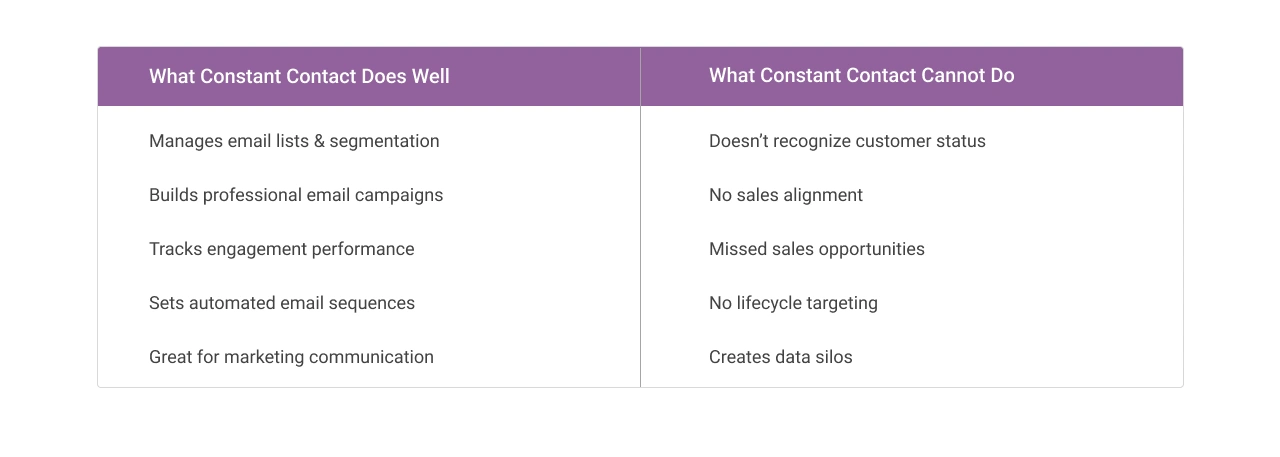
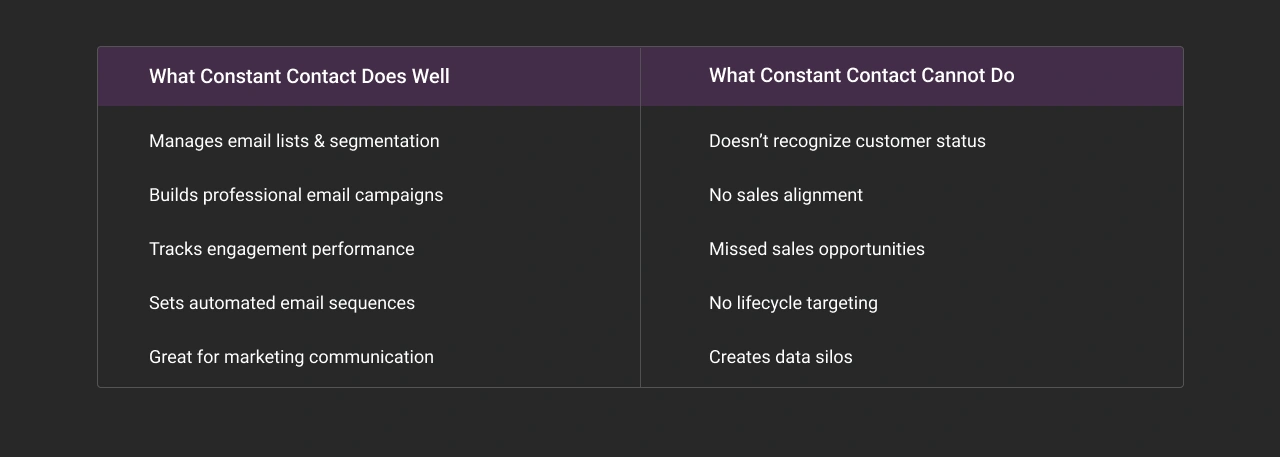
How does the Constant Contact and Salesforce integration solve its limitations?


This integration works as a bridge between your sales and marketing teams by automating data flow across both tools. It solves core limitations by syncing two key types of information:
- Contact identity and status: Who your contacts are in Salesforce, including their identity and current status, such as whether they’re a new lead, a prospect, or an existing customer.
- Contact engagement and intent: How they engage with your marketing in Constant Contact, including which emails they open and which links they click.
Here’s how this integration actually works:
Flow 1: From Salesforce to Constant Contact


When a new lead is created or when a contact’s details (such as product interest or industry) are updated in Salesforce, the information automatically updates in the related Constant Contact list.
For example, if a sales rep qualifies a lead for “Enterprise Services” in Salesforce, that lead is automatically added to an “Enterprise Nurture” email sequence in Constant Contact.
Flow 2: From Constant Contact to Salesforce


When a contact opens an email or clicks a link, that activity is recorded as a task or note on their Salesforce record.
For example, when a prospect clicks a “Request a Demo” link in your email. Instantly, a high-priority task is created for your sales rep in Salesforce, enabling them to follow up with a sales-ready lead.
This is how the integration between Constant Contact and Salesforce works and transforms two separate tools into a robust engine for growth.
To see how similar workflows operate across other platforms, check out you can explore our complete Salesforce integration guide for a broader view of how systems share data with Salesforce.
Constant Contact and Salesforce integration options
There are multiple ways through which you can integrate Salesforce with Constant Contact. Choosing the methods mainly depends on your requirements, budget, and technical resources.
1. Native through Constant Contact Account
It is a native, pre-built connector that is provided directly within your Constant Contact account. You can access it through the platform and connect to Salesforce by logging in and mapping the fields.
How does it work?
This is the direct method of integrating Constant Contact with Salesforce. Through Constant Contact, you can set up to map your contacts and sync email engagement data.
Best for:
Businesses needing a simple, straightforward, native method for core syncing tasks like managing contracts and tracking email opens/clicks.
Cons:
- You can not map unique Salesforce fields for segmentation.
- You can not create custom “If-then” rules, as it works on pre-built sync patterns, preventing custom workflows.
2. Third-party tools/Middleware
Platforms like Mulesoft act as a middleware between Salesforce and Constant Contact. You do not need to code; you use a visual interface to create rules.
How does it work?
It is like having a smart assistant who watches one app and performs an action in the other. “If a new Lead is created in Salesforce (the trigger), then add them to a specific list in Constant Contact (the action).”
Best for:
Teams that need to sync custom data fields or create complex, multi-step workflows that the native solution does not support.
Cons:
- Vendor lock-in and recurring costs; your integration depends on the tool’s ongoing health.
- When a sync fails, you have to diagnose three systems (Salesforce, Constant Contact, and the middleware tool) instead of two.
3. Custom API Development
This involves having a Salesforce developer who writes the custom code to integrate Salesforce and Constant Contact directly via their APIs (Application Programming Interfaces), or you can opt for the custom Salesforce API development from the provider.
How does it work?
It is like building a custom bridge from scratch; you have complete control over the design, materials, and everything that crosses it.
Best for:
Large enterprises with unique, complex requirements that the other options can not handle. It requires time and technical resources to invest.
Cons:
- High total cost of ownership; requires not just initial development but a dedicated budget for ongoing API update maintenance and bug fixes.
- Long deployment timelines, it takes a long time to build and test, unlike the instant setup of the other two methods.
| Method | Integration process | Cost | Flexibility |
|---|---|---|---|
| Native solution | Easy, straightforward | Low | Low |
| Third-party tools | Moderate | Medium | High |
| Custom API development | Difficult | High | Highest |
The expert take: For most businesses, the choice is between the native solution and a third-party tool. If your needs are straightforward and you want the easiest path, the native solution is your best bet. If you have custom fields or complex automation needs that the native tool does not cover, a third-party tool is worth the investment for the extra flexibility.
We’re using the native method because it’s the fastest, most accessible option, with no extra tools or custom code required. It lets you experience the core value of the integration and build on it later if needed.


How to set up the Constant Contact Salesforce integration (Step-by-step guide)
This guide walks you through the native integration method. But before starting, you must ensure you meet these prerequisites for seamless integration.
Integration prerequisites:
- Salesforce edition: You must be using an Enterprise, Unlimited, Performance, or Professional edition of Salesforce.
- API access: API Access must be enabled in your Salesforce org, which is enabled by default for Enterprise, Unlimited, and Performance editions. For the Professional edition, you need to purchase API access from Salesforce.
- Permissions: The CRM user must be an integration user (also known as an API user) and must have the API only permission applied.
- The CRM user must have modified all data selected within the system administrator profile of Salesforce.
- Integration user: You must use a dedicated “API User” in Salesforce for the connection. This user’s profile must have “Modify All Data” permission, and its password should be set to never expire to prevent the integration from breaking unexpectedly.
Step 1: Login/start trial on Constant Contact:
(a) Access your Constant Contact Account; if you don’t have one, you can start a trial.

(b) Fill in the details and click get started.

(c) Select your goals and continue.

(d) Enter your address and continue.
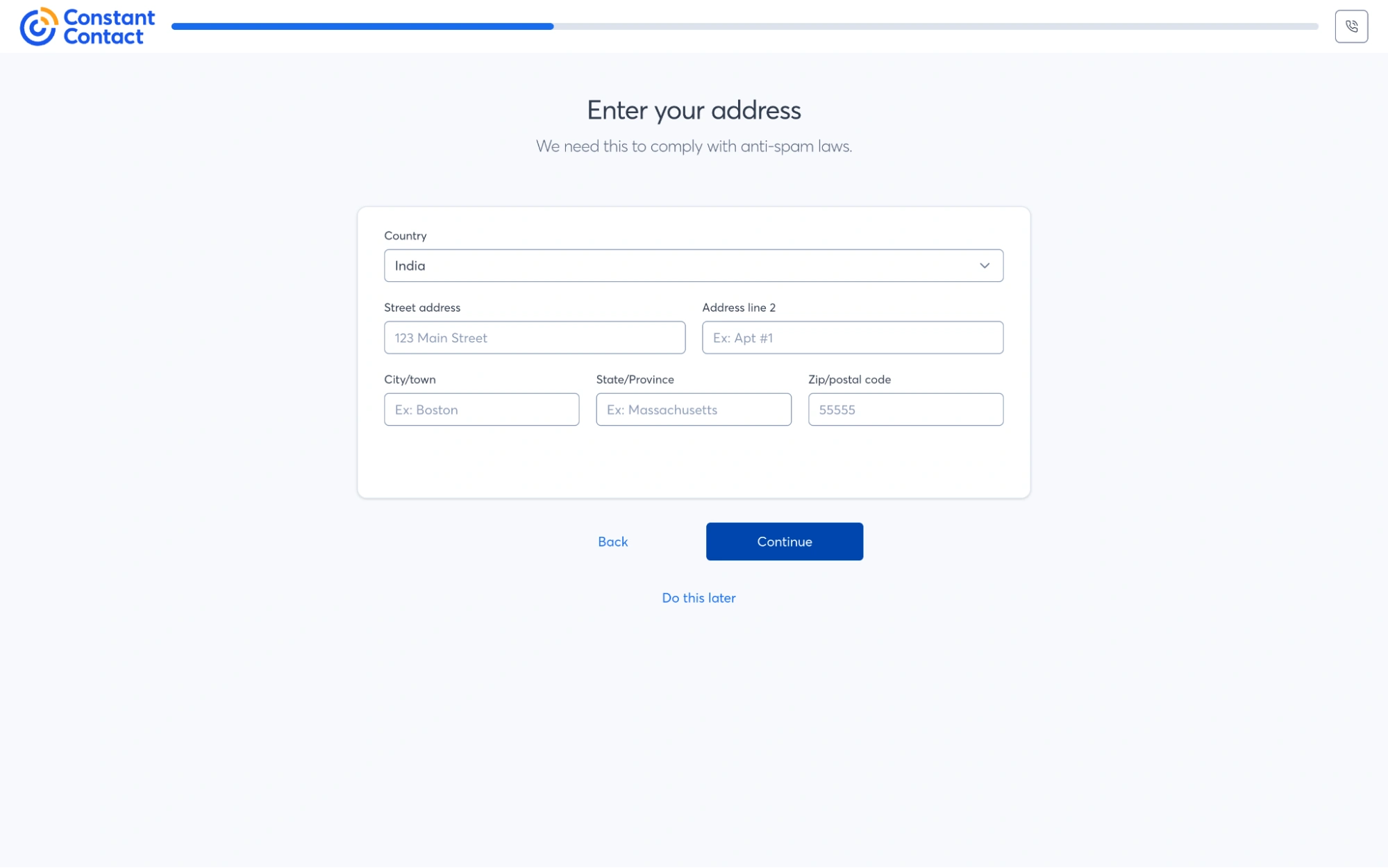
(e) Select the number of email contacts.

(f) Add a few contacts with a comma separated or press enter.

(g) Enter your website domain.
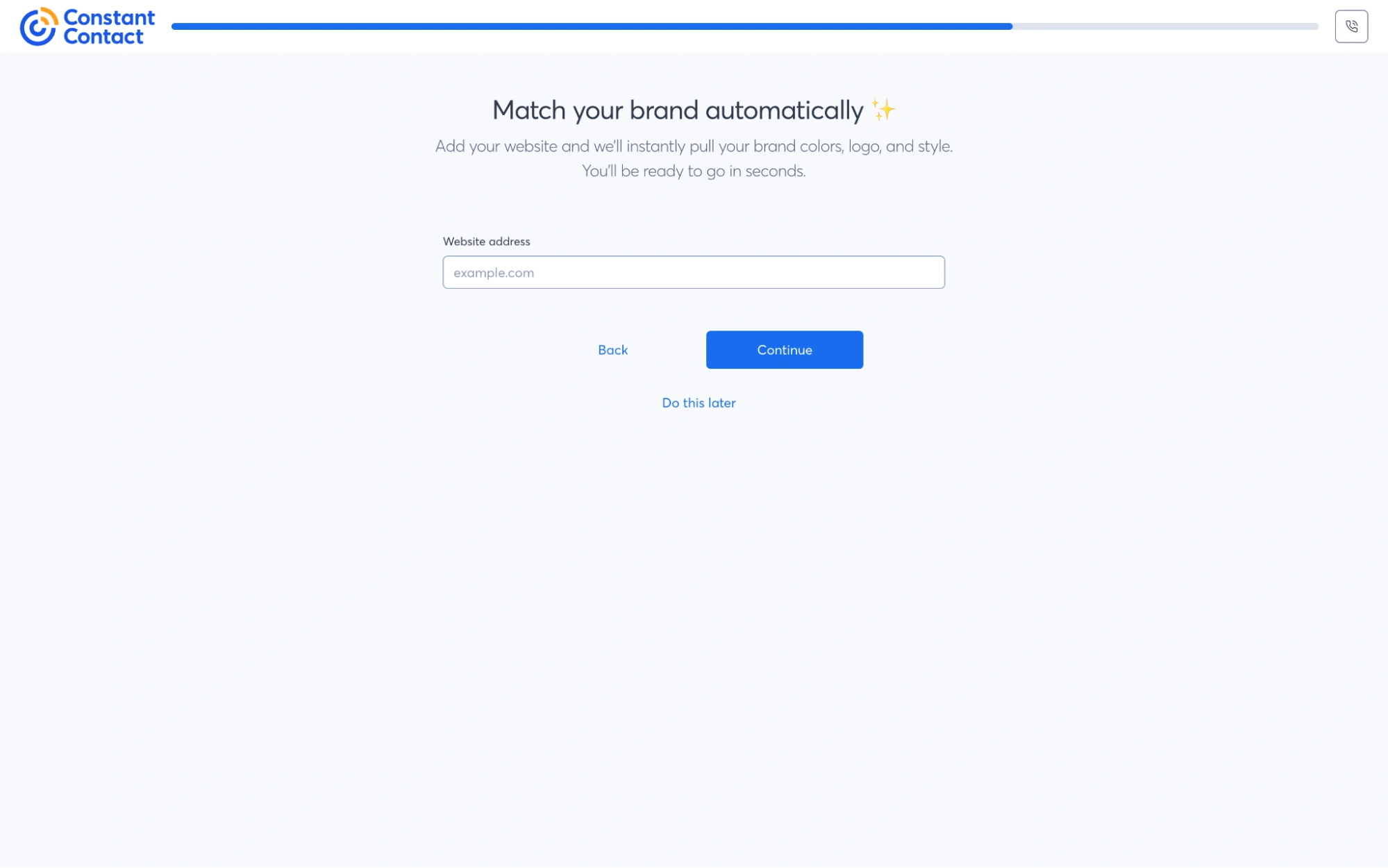
(h) Check your email and verify your email.
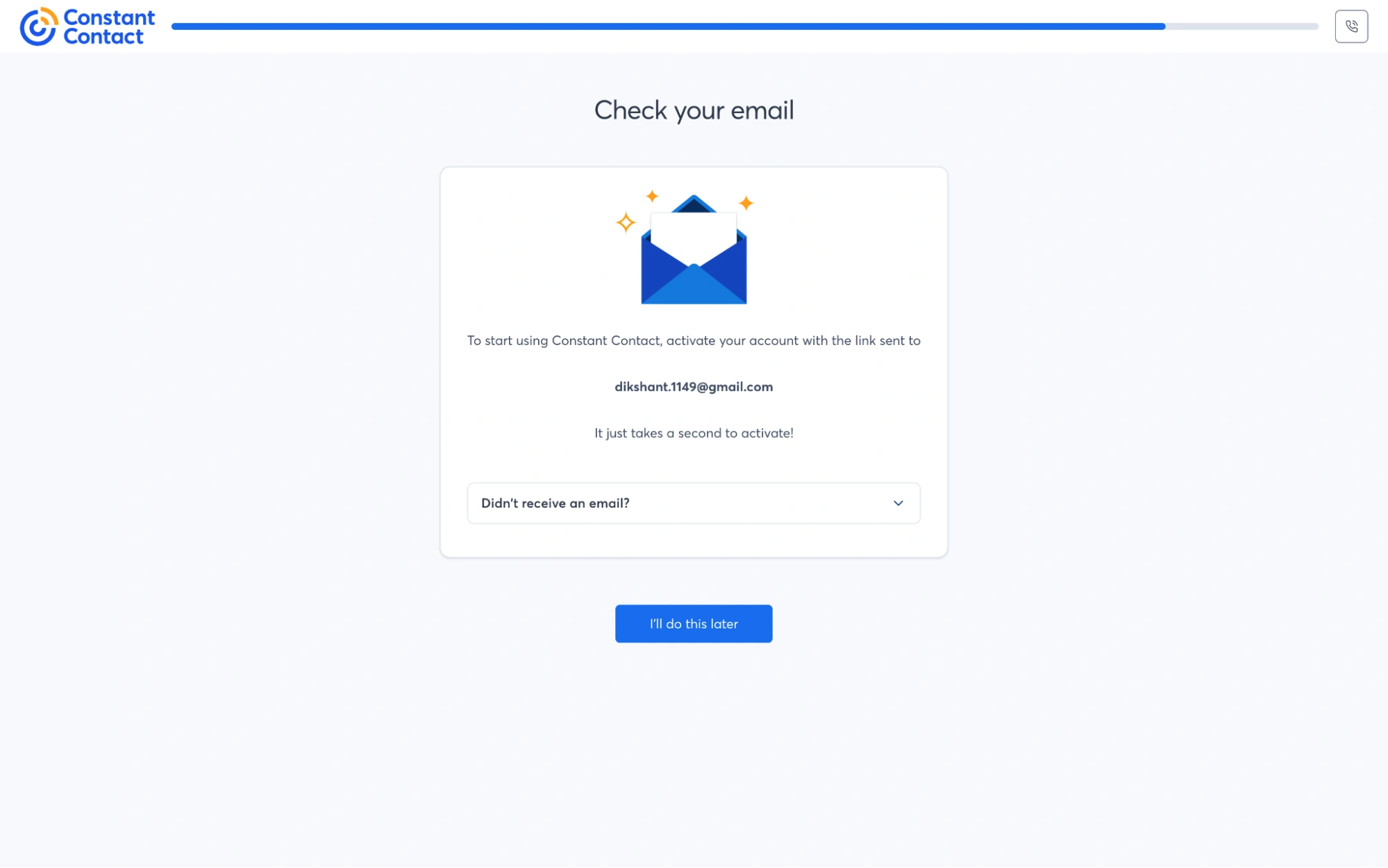
Step 2: Navigate to integrations
(a) From the main dashboard, toggle to the integrations (e.g., this is the first screen of the instance).
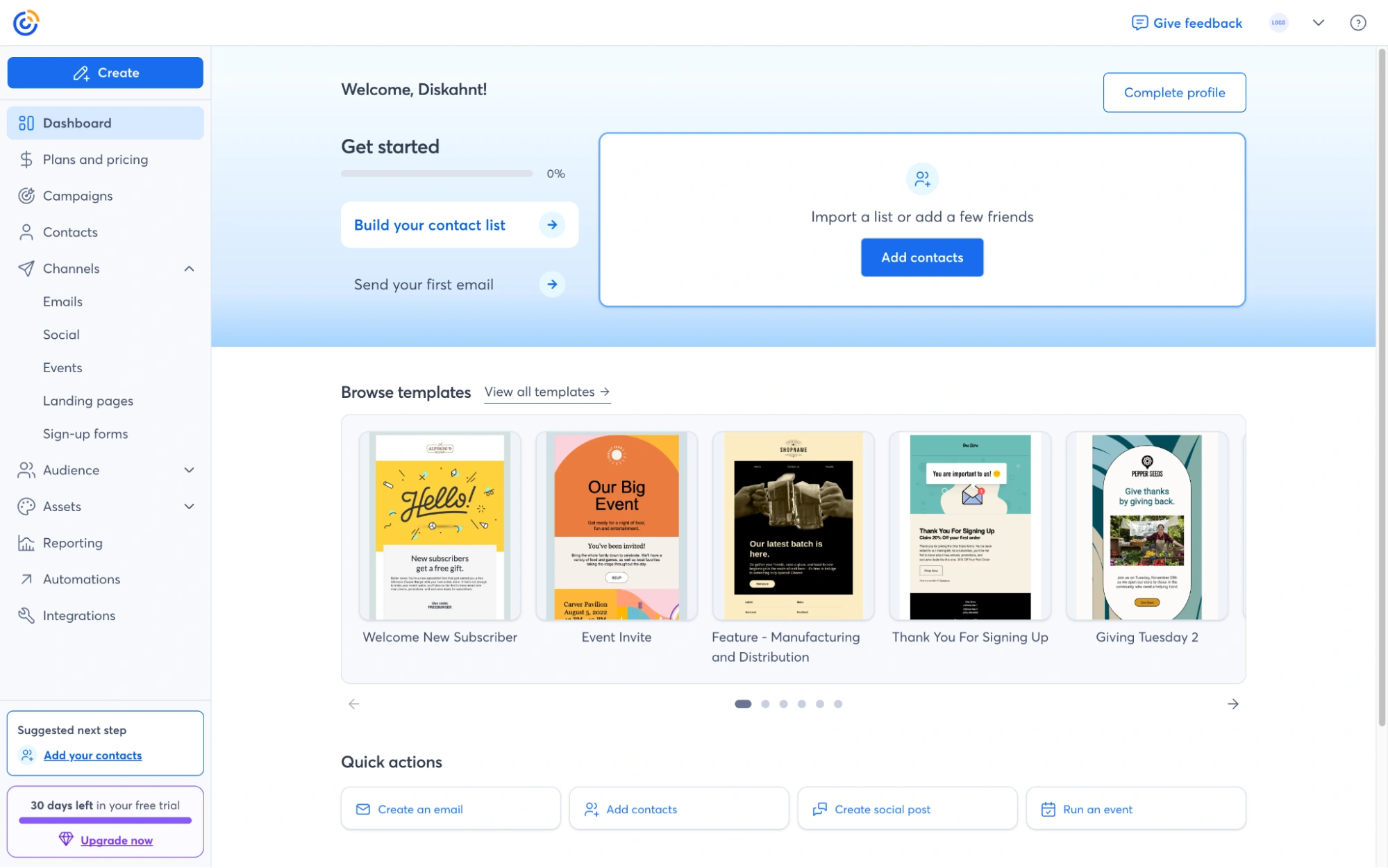
(b) From the integration tab, search for Salesforce
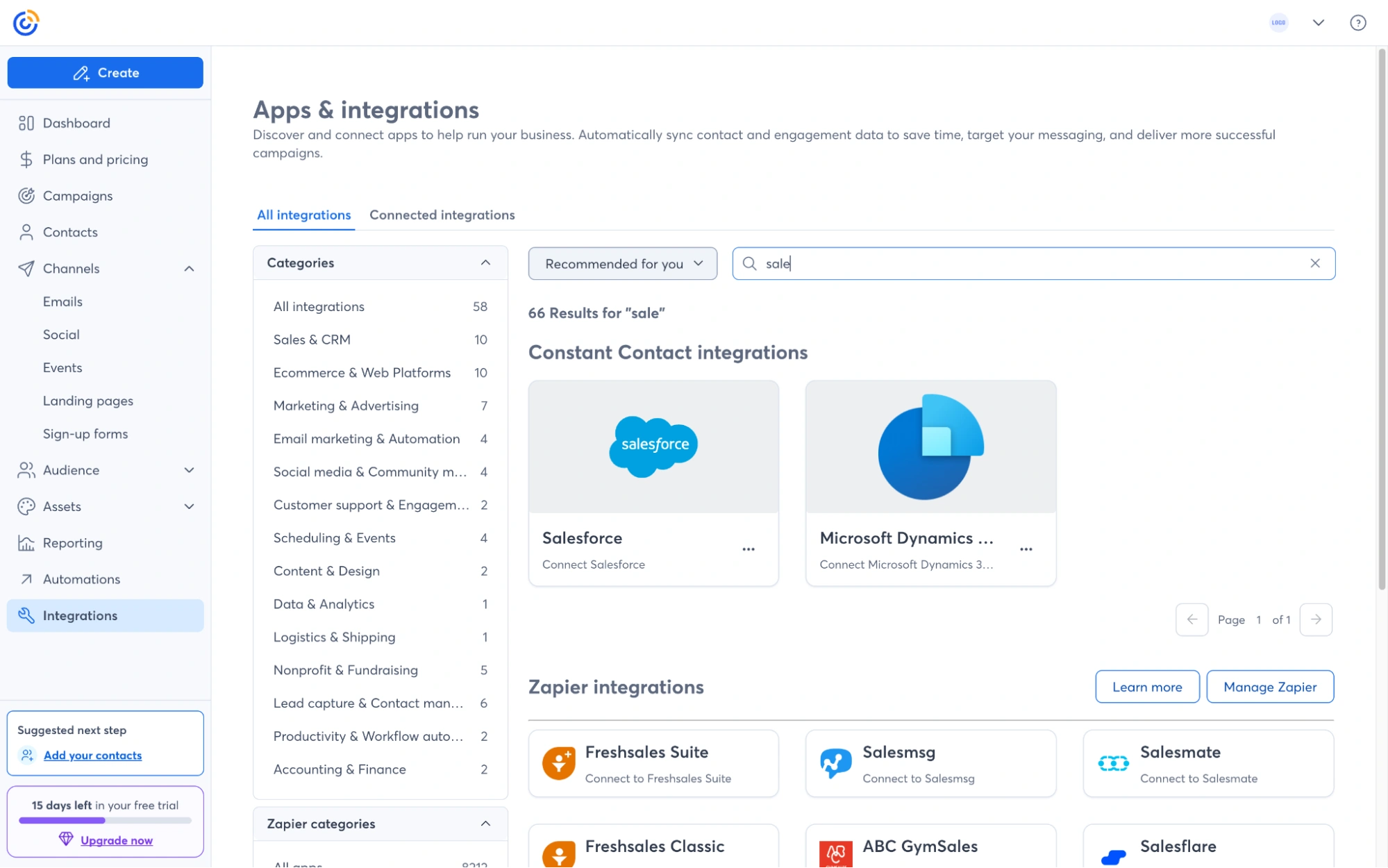
Step 3: Connect to your Salesforce instance
(a) After clicking on connect, it will redirect you to the Salesforce login page. Then, log in to your environment (note: use the dedicated integration user credentials).

Step 4: Configure the sync
(a) Selecting contacts: Once logged in, click on import and select the option you want to import from Salesforce.

(b) Mapping fields: Map the fields (like “Industry” to corresponding fields in Constant Contact) and continue.

(c) Setting preferences: Configure settings according to your sync needs, such as how often data should update.
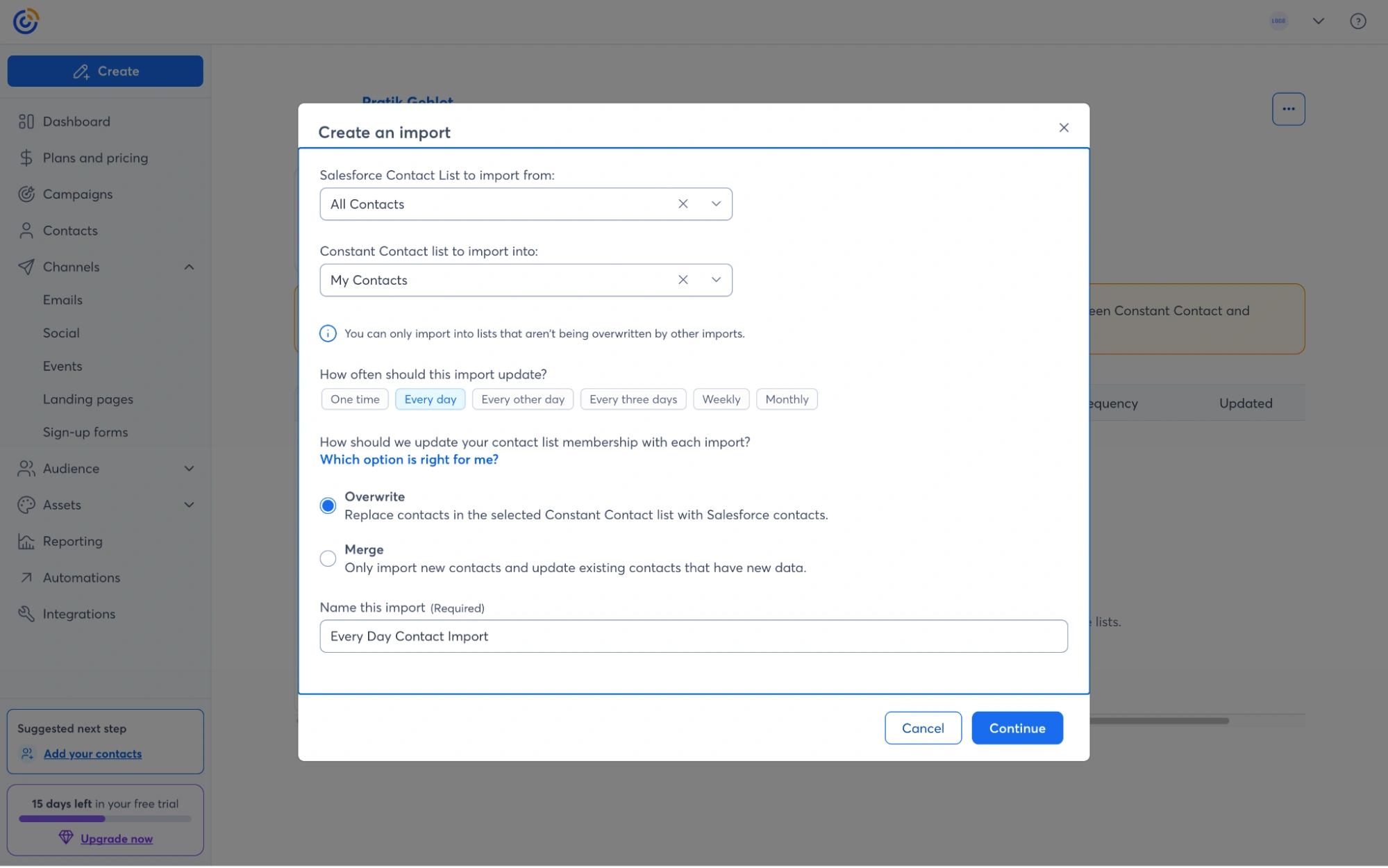
(d) Click on import.

Step 5: Verify the connection
(a) It will be in progress status a few times.
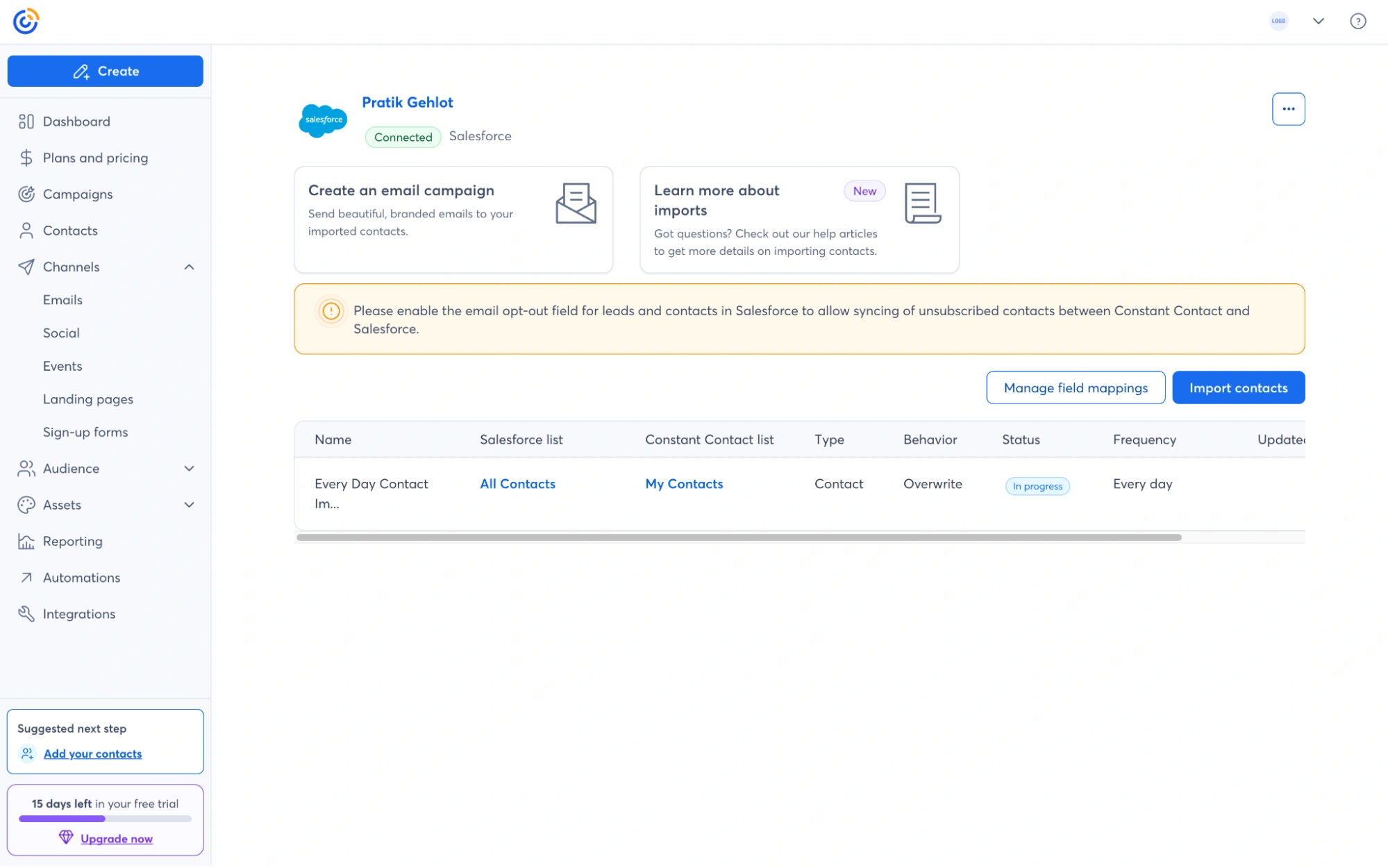
(b) After the sync finishes, review your Constant Contact list to confirm the Salesforce contacts. You can also test it by updating a record in Salesforce and checking if it updates in Constant Contact.
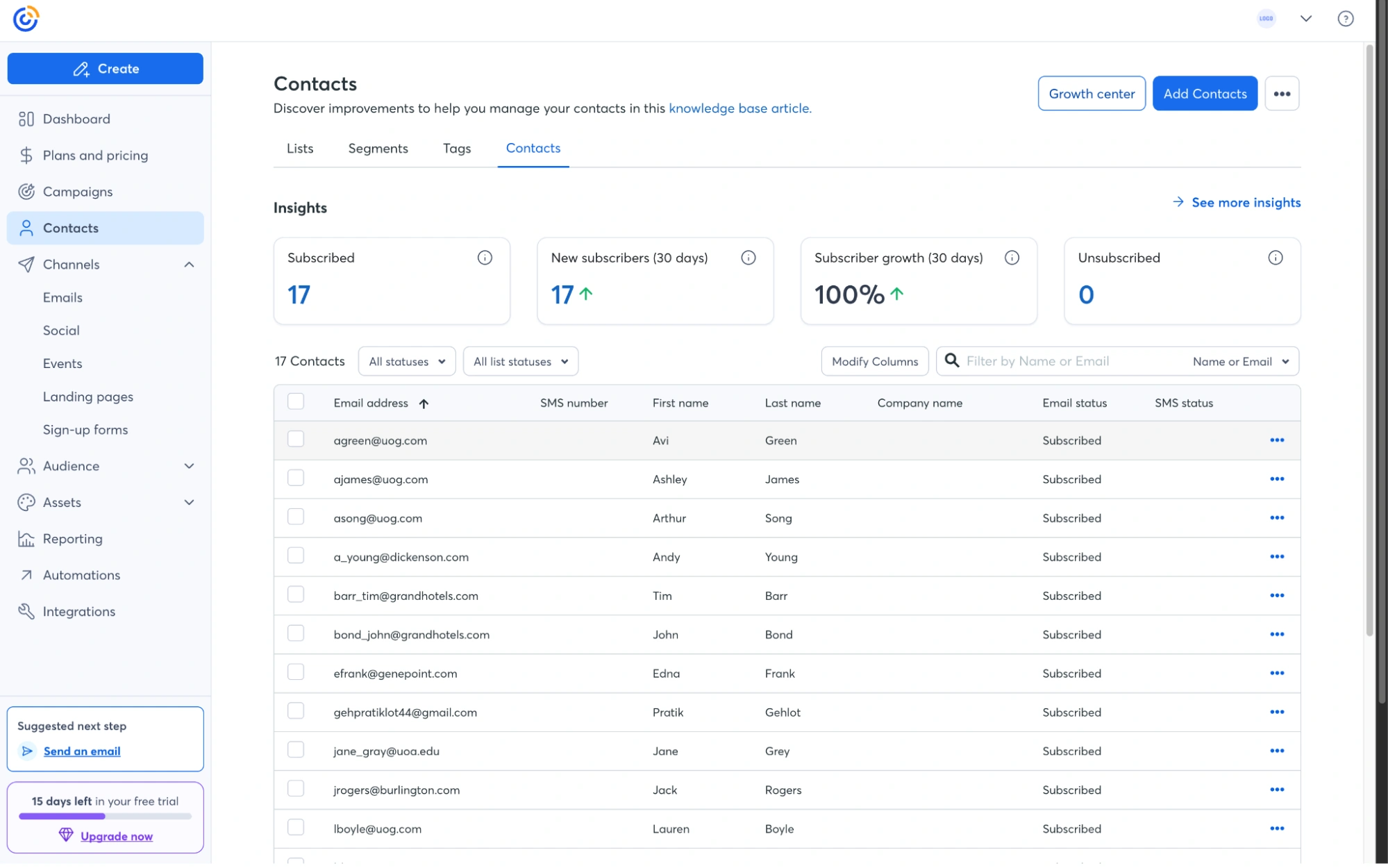
Congratulations, your Constant Contact Salesforce integration is now active.


Benefits of Salesforce and Constant Contact integration
Integrating Salesforce with Constant Contact creates a single source of truth. Here are the other benefits, which you can get:


1. Automated List Segmentation
The integration eliminates the manual list upload tasks from Constant Contact to Salesforce. Your segments in Constant Contact automatically update based on real-time data from Salesforce, like a contact’s industry or a changed opportunity stage. It enables your marketing efforts to always be targeted and timely.
2. Closed-loop Reporting
You can track a closed-won deal in Salesforce all the way back to the specific email campaign that started the conversation after the integration. This proves marketing’s ROI and justifies your budget.
3. Personalized Email Journeys
Use Salesforce data, such as a contact’s industry or the product they have shown interest in, to send relevant content from Constant Contact. A lead from a tech company gets a different message than one from healthcare.
4. Time Saving
Eliminate hours of manual putting the status of a prospect/lead. This gives your team time back to focus on strategy, not spreadsheets.
5. Protect Customer Relationships
When an Opportunity in Salesforce moves to “Closed-Won,” you can automatically move that contact to a “Customer Only” list in Constant Contact. This stops you from accidentally sending them a “Buy Now!” promo.
Common Integration Challenges and Best Practices to fix them
To ensure a successful integration between Salesforce and Constant Contact, here are a few things that you should avoid:
1. Redundant Data
Businesses syncing systems with duplicate or outdated contacts leads to marketing emails being sent to invalid addresses and cluttered lists.
How to avoid?
Before connecting the two systems, you should:
- Run a de-duplication process in Salesforce using its built-in duplicate management rules to identify and merge duplicate records, as well as deactivate outdated contacts.
- Use its “Check for duplicates” feature during initial import in Constant Contact.
- Most importantly, you can establish Salesforce as your single “Source of Truth” for data like email addresses to prevent conflicts and ensure ongoing consistency across both platforms.
2. Inappropriate Alters Overwhelmning your Teams
If your integration creates a new task for every single email open, your sales team will be overwhelmed by every alert and may miss the important signals.
How to avoid?
You should configure your integration to create high-priority tasks only for high-intent actions, such as when a lead clicks a “Request a Demo” or “Pricing” link, instead of for every email open. This helps your sales team focus on the most qualified leads.
3: Setup Stops Working
A common issue is the integration stopping unexpectedly, usually because the password for the dedicated Salesforce user has expired or a security setting has been changed.
How to avoid?
You can create a dedicated system user for the Salesforce integration with Constant Contact. Instead of using an employee’s login, you can set up a specific user in Salesforce for this task. This user’s password is set to never expire and has all the permissions it needs. This prevents the integration from breaking if an employee leaves or changes their password.
4. Hitting Salesforce API limits
If you do not properly set up integration for a large database or frequent sync, it can exhaust the API limits of your plan. This can cause critical processes to fail.
How to avoid?
You should monitor API usage in Salesforce Setup. For a larger database, you should configure the integration to sync less frequently, such as every four hours instead of every hour. Additionally, you can use selective filters to sync only active records, like Lead Status = Nurturing, instead of the entire database.
5. Incorrect field mapping creates confusion
Mapping a Salesforce field like “Industry” to the incorrect Constant Contact field can disrupt segmentation, sending tech emails to healthcare contacts.
How to avoid?
- Create a mapping document: Before integrating Salesforce and Constant Contact, you can list every field you plan to sync and its related fields in the other system.
- Use descriptive field names: In Constant Contact, you can rename custom fields to match their related Salesforce fields, such as SF_Product_Interest, to prevent mapping errors.
Pro tip: You can take help from the Salesforce system integrators to ensure the success of the integration. They can guide you through mapping fields, using the clean data, and setting clear sync rules, leading you to get better results after the integration.


How to Measure the Success After Salesforce and Constant Contact Integration?
Even after avoiding the mistakes and properly configuring the integration between Salesforce and Constant Contact, here’s how you can measure whether the integration is successful or not.
1. Lead Response Time
How quickly does a salesperson contact a lead after they click a key link in an email? Before integration, this might take days. After the integration, you will get this in minutes.
2. From Clicks to Customers
You should not celebrate email clicks. Instead, you can track how many of those clicking leads actually turn into qualified opportunities. If this number goes up after integration, it means your sales team is using the email data effectively to connect with the right people.
3. Reduction in Manual Tasks
You should track the time your team saves after the integration. For that, you can measure how many hours per week are saved by your teams on exporting lists, importing contacts, and manually updating records? It is a direct efficiency gain of cost savings and allows your team to focus on more strategic work.
4. KPIs
You can track these key performance indicators (KPIs) to measure business outcomes:
- Lead to opportunity conversion rate: You can measure post-integration marketing qualified leads turning into sales pipelines. The increase in this graph highlights the integration success.
- Click to open rates: Instead of checking click-through rates, this metric helps you measure how engaging your content is to the people who actually opened the email. A rising CTOR defines the Constant Contact Salesforce integration success, which means your content is being sent to the right audience.
- Lead response time: You can track the average time between a lead clicking the link in an email and your sales team taking follow-up on that. The drop in this duration highlights the success of integration.


Conclusion
The integration does not just sync data, but it replaces manual processes with an intelligent system that actively nurtures leads and improves customer relationships.
While the technical Constant Contact Salesforce sync might seem straightforward, how you set it up, including clean data, field mapping, and automation, is what separates it from a basic connection.
If you/your team feel overwhelmed in managing prerequisites, API users, and data mapping, you can hire Salesforce integration services from Cyntexa. We offer certified experts who have already performed 100+ integration projects. Choosing us will help you create the roadmap and set up the integration for success.
Let’s take the first step by booking a free meeting to discuss your requirements.
Don’t Worry, We Got You Covered!
Get The Expert curated eGuide straight to your inbox and get going with the Salesforce Excellence.
AUTHOR
Shubham
Service Cloud, Salesforce Managed Packages
With over 5 years of experience, Shubham specialize in curating solutions on Salesforce Service Cloud, Nonprofit Cloud, Consumer Goods Cloud, Managed Packages, and ServiceNow ITSM. He designs and implements end-to-end service solutions that improve operational workflows and ensure seamless integration across enterprise systems. Shubham’s expertise lies in creating secure, efficient, and agile platforms tailored to unique business needs.


Cyntexa.
Join Our Newsletter. Get Your Daily Dose Of Search Know-How
Frequently Asked Questions
No, there is no native Constant Contact app available on the Salesforce AppExchange.
Yes, the email marketing platform offers its own built-in connection to Salesforce. It can automatically bring over customer and lead details for use in email lists. In addition to the official connector, other integration tools and custom solutions can also be used.
No, the native option (through Constant Contact Account) integration provides one-way synchronization, pushing data from Salesforce to Constant Contact. For the two-way (bidirectional) synchronization, you need to choose the third-party tools integration option.. These tools allow custom field mapping to keep your contact data consistent across both systems.
The cost depends on how you set it up. The standard connector doesn’t require an extra fee, but you still pay for each platform individually. For example, Constant Contact has plans starting around $12, and Salesforce pricing varies by product and user licenses.












